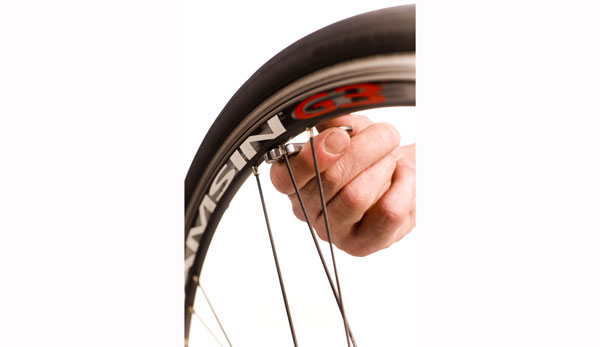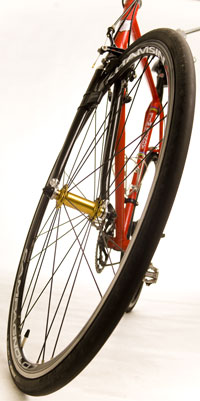On-the-run wheel repairs can be surprisingly effective, writes Stephen Huntley.
 Discovering a wobbly wheel while out on a ride is annoying. Depending on how great the wobble is, it can lead to your tyre rubbing on the frame (possibly causing a hard-to-fix sidewall puncture), your tyre may rub on your brakes (very annoying when you’re going uphill) and it might also lead to broken spokes and a complete wheel failure.
Discovering a wobbly wheel while out on a ride is annoying. Depending on how great the wobble is, it can lead to your tyre rubbing on the frame (possibly causing a hard-to-fix sidewall puncture), your tyre may rub on your brakes (very annoying when you’re going uphill) and it might also lead to broken spokes and a complete wheel failure.
If you’re up for it, a rough and ready in-situ wheel truing can get the wheel reasonably well aligned, and you can get back to enjoying your ride.
Get a feel for it
Stand the bike upside down on its saddle and handlebars, position yourself on one side of the faulty wheel, grab a couple of adjoining spokes about three-quarters of the way towards the rim, and squeeze them together. Roughly gauge the tension. Then do the same for the next couple, and so on round this side of the wheel, and then do the same for the other side of the wheel. Try and judge if any spokes feel particularly loose and lacking tautness compared to the other spokes in the wheel.
Loose spoke
If you find a loose spoke, use your spoke key to tighten it up (anti-clockwise turns looking from below the rim) with quarter turns till it seems at close to the same tautness as the other spokes.
 Roughly true
Roughly true
Now spin the wheel slowly and look for areas where the rim bulges towards your brake pads on the chain side of the bike. Make note of the first bulge you find. You want to tighten the three or four spokes that feed into the opposite side of the rim to the bulge. The spokes you need to tighten will emanate from the hub on the non-chain side of the bike, and by tightening them you will pull the rim towards that side.
Tighten the spoke nipples (anti-clockwise turns looking from below the rim) in quarter turns. Check the bulge against the brakes again, and keep gradually tightening the spokes on the opposite side until the bulge is close to non-existent.
Do the same for any other bulges you find on this side of the wheel, then turn your attention to the non-chain side and do the same. You should quickly and relatively easily be able to get your wheel close to round.
Broken spoke
If you have a broken spoke, and you carry a replacement, remove the wheel, the tyre, inner tube, rim tape and broken spoke. Thread through the new spoke in a pattern consistent with the other spokes on that side of the wheel, and tighten the spoke nipple (anti-clockwise turns as you look from below the rim). Try and feel for a tension that seems close to the other spokes. Then follow the procedure under ‘Roughly true’.
If you don’t have a replacement spoke, remove the broken one and nurse the bike home. You may have to release the brakes on that wheel so that it will spin freely; this will leave you with just one effective brake, so ride slowly and cautiously.
Ride On content is editorially independent, but is supported financially by members of Bicycle Network. If you enjoy our articles and want to support the future publication of high-quality content, please consider helping out by becoming a member.

All the above is true advice (accidental pun…), but I would add a caution to check the tension on the bulge side before tightening the slack side. Sometimes it’s necessary to slacken the bulge side spokes a little to avoid creating a flat spot around the repair. Another point is that spokes cloase to the bulge will need a little more adjustment than the one or two following away from the bulge, in both directions. The same is true if it’s necessary to slacken any.
Another ‘trick’ I use is to lightly tap the spokes with a metal object (spoke spammer, screwdriver shaft- not handle), and listen, like tuning a stringed instrument.